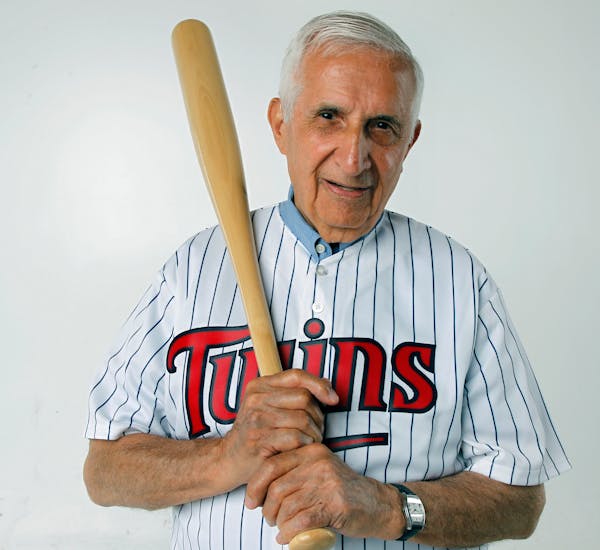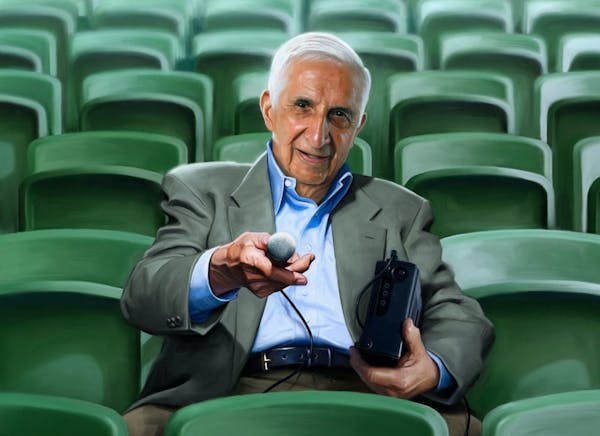Sid Hartman was 27 years old when he began making player personnel decisions for the Minneapolis Lakers pro basketball team in 1947. It was, as Hartman often noted, a different newspaper era than the one he encountered in his later years, when editors became increasingly concerned about conflicts of interest.
In 1947?
"[Lakers co-owner Ben] Berger wanted me to quit the paper and run the Lakers as the general manager," Hartman said in his autobiography, "Sid!" "I considered that, but it was not an either-or situation. This was a time when most of the sportswriters had something else going. Frank Diamond did the promotion for boxing. Rolf Fjelstad did the promotion for wrestling. Halsey Hall wrote releases for the Minneapolis Millers baseball team.
"Newspapers paid so little back then that the editors had no problem with reporters having another job on the side."
You could argue that this was hardly a job on the side. From Hartman's perspective, it was he who presented Berger and Morris Chalfen with the idea of bringing pro basketball to Minneapolis. It was Hartman who brokered the deal to buy the Detroit Gems and move the franchise to Minnesota. It was Hartman who met Gems owner Morris Winston at the Detroit airport, handed him the $15,000 check for the purchase price, and got Winston to sign the purchase agreement.
And it was Hartman who in essence became the general manager for a Lakers team that won six league championships in seven years starting in 1947-48 — the first in the NBL, the final five in the NBA following the merger of the NBL with the Basketball Association of America (BAA).
Hartman claimed these as his greatest moves:
• Signing Jim Pollard to a free-agent contract. Pollard had finished at Stanford and was playing for an Oakland team in an industrial league. Hartman was attending an NBL meeting in Chicago, listening to league Commissioner Doxie Moore lecture owners against paying big money to players, specifically Pollard. Hartman said he raised his hand in the middle of Doxie's talk and said: "Commissioner, I would like to announce that the Minneapolis Lakers have signed Jim Pollard."
• Hartman said he also persuaded Chalfen and Berger to shell out big money, $15,000, to purchase the rights to Minnesotans Tony Jaros and Don Carlson from the Chicago Stags of the BAA. The pair played prominent roles on the Lakers' first two championship teams.
• Very likely Hartman's biggest contribution came in "getting lost" on his way to the airport before the 1947-48 season. The Lakers were trying to sign free-agent center George Mikan but were engaged in a battle with the Chicago Stags of the BAA.
Mikan was seeking $12,000, which "was a ton of money" at the time, Hartman said in his book. The Lakers initially dragged their feet, and Mikan decided he was flying back to Chicago, which could have ended the Lakers' chances.
"Max [Winter, who had become a team executive] and I talked it over and figured that if Mikan got on that flight, he was gone for good," Hartman said. "So I drove Mikan to the airport, and I made sure to get lost on the way. I drove north toward Anoka, rather than south toward the airport.
"After Mikan missed his flight, we put him up in a downtown hotel, then brought him to the Lakers office in the Loeb Arcade the next morning and agreed to give him the $12,000."
• Never one to downplay his contributions, Hartman said he completed the building of the Lakers' dynasty with "the greatest one-season draft in the history of the NBA" in 1949. Hartman's haul: power forward Vern Mikkelsen from Hamline in the first round, point guard Slater Martin from Texas in the second and guard Bobby Harrison from Michigan in the third.
All three players became immediate starters. Hartman called it the "prototype for the type of lineup NBA teams still try to put together today." Mikan as a dominant inside center, Mikkelsen at power forward, Pollard at small forward, Harrison and Whitey Skoog as shooting guards and Martin at point guard.
Hartman's only regret was that he thought he had set up a scenario to ensure the Lakers' dominance much longer than it lasted — the Lakers won their last title in 1953-54, had a winning record the following season, then suffered through five straight losing seasons and declining attendance before the franchise relocated to Los Angeles before the 1960-61 season.
With the Lakers having started their decline in 1954-55, Hartman maintained he had a deal in place to send Mikkelsen to Boston for three former Kentucky players who were serving in the armed forces that season: Cliff Hagan, Frank Ramsey and Lou Tsioropoulos. There was an important Part II to the plan: Hartman was certain that the Lakers without Mikkelsen or any of the Kentucky players available would have finished with the worst record, affording them the No. 1 draft pick. Hartman had already targeted University of San Francisco center Bill Russell as the man he wanted.
According to Hartman, Lakers radio play-by-play man Dick Enroth was a huge Mikkelsen fan and didn't want to spend the 1954-55 season watching a last-place team. Enroth took Berger out to lunch and pleaded with him not to make the deal. Berger opted to hold on to Mikkelsen, and the rest is history. Russell was drafted by Boston and proceeded to lead the Celtics to 13 titles in 15 seasons.
Hartman stopped working for the Lakers in 1957. But he returned to the NBA in 1961-62, making personnel decisions for the Chicago Packers expansion team. The franchise was moved to Washington, becoming the Bullets, in 1963-64.
Hartman said the team's owners wanted to bring the club back to Chicago the next season, and wanted to let him run the club if he would move to Chicago. But Hartman decided his Minneapolis roots were too deep, so he remained at the newspaper, turning his focus to helping the Twin Cities land a Major League Baseball franchise. Hartman said he always wondered what might have been had the Lakers landed Russell. He knew what the failure to complete that deal meant.
"Our dynasty was over," Hartman said. "The NBA belonged to Russell and the Celtics."
Jordan Montgomery wins in debut, Diamondbacks get 22 hits in 17-1 win over Giants
Ingram, Valanciunas lift Zion-less Pelicans past Kings and into the playoffs
Justin Turner's homer, RBI single highlight Blue Jays' 5-1 win over the Padres
![Minnesota Twins pitcher Jhoan Duran (59) in the ninth inning Tuesday, August 15, 2023, Target Field in Minneapolis, Minn. ] CARLOS GONZALEZ • carlos](https://arc.stimg.co/startribunemedia/NWLT5CNXGTRZA6KVTMIPSOG3KI.jpg?h=91&w=145&fit=crop&bg=999&crop=faces)

